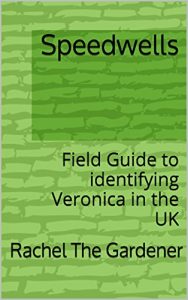“Err – what's the difference between Speedwells and Forget-me-Not?”
Forget-me-nots (Myosotis) have five petals, Speedwells have four. There you go, that's how easy botany can be!
Ah, but which Speedwell are you looking at? Over a dozen of the most commonly-found species of this group are detailed here, from the hairy-stemmed Veronica hederifolia, through to the stout and fleshy Veronica Beccabunga, which always sounds to me like the name of the heroine in a book about a plucky female detective.
This Crib covers this group of small, delicate little wildflowers that pop up on rough ground, on grazed fields, and in hedgerows, along the paths, tracks, towpaths and disused railways of the UK: these areas are great resources for Botanists, as the flowers which grow along them can be visited for free, year after year, so you can track the development of annual plants, and observe the growth of perennials ones.
This Field Guide is one of a series of books intended for use in the field by UK Botanists, both Improvers and complete beginners, to help swiftly narrow down the identification of a plant, and to extend your knowledge and understanding of the genus.
They cover commonly found UK species, and are not intended to replace a full-length Field Guide such as Poland or Rose: but they present the salient information in an easy-to-read format, to people who have gone beyond having to key out every single plant, and who are now trying to learn the difference between species.
The Kindle is the perfect format for this, as you can look up any words you don't understand in the Kindle dictionary, and then annotate the Table to remind yourself.
Originally they were in the form of a pack of A6 cards on a ring, and you may prefer to print out the Crib to take with you: but if you can take your Kindle out botanising with you, then so much the better!
Forget-me-nots (Myosotis) have five petals, Speedwells have four. There you go, that's how easy botany can be!
Ah, but which Speedwell are you looking at? Over a dozen of the most commonly-found species of this group are detailed here, from the hairy-stemmed Veronica hederifolia, through to the stout and fleshy Veronica Beccabunga, which always sounds to me like the name of the heroine in a book about a plucky female detective.
This Crib covers this group of small, delicate little wildflowers that pop up on rough ground, on grazed fields, and in hedgerows, along the paths, tracks, towpaths and disused railways of the UK: these areas are great resources for Botanists, as the flowers which grow along them can be visited for free, year after year, so you can track the development of annual plants, and observe the growth of perennials ones.
This Field Guide is one of a series of books intended for use in the field by UK Botanists, both Improvers and complete beginners, to help swiftly narrow down the identification of a plant, and to extend your knowledge and understanding of the genus.
They cover commonly found UK species, and are not intended to replace a full-length Field Guide such as Poland or Rose: but they present the salient information in an easy-to-read format, to people who have gone beyond having to key out every single plant, and who are now trying to learn the difference between species.
The Kindle is the perfect format for this, as you can look up any words you don't understand in the Kindle dictionary, and then annotate the Table to remind yourself.
Originally they were in the form of a pack of A6 cards on a ring, and you may prefer to print out the Crib to take with you: but if you can take your Kindle out botanising with you, then so much the better!






